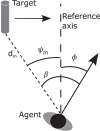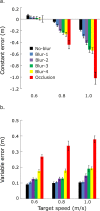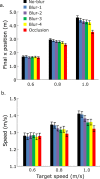Intercepting a moving target: On-line or model-based control?
- PMID: 28538992
- PMCID: PMC6097582
- DOI: 10.1167/17.5.12
Intercepting a moving target: On-line or model-based control?
Abstract
When walking to intercept a moving target, people take an interception path that appears to anticipate the target's trajectory. According to the constant bearing strategy, the observer holds the bearing direction of the target constant based on current visual information, consistent with on-line control. Alternatively, the interception path might be based on an internal model of the target's motion, known as model-based control. To investigate these two accounts, participants walked to intercept a moving target in a virtual environment. We degraded the target's visibility by blurring the target to varying degrees in the midst of a trial, in order to influence its perceived speed and position. Reduced levels of visibility progressively impaired interception accuracy and precision; total occlusion impaired performance most and yielded nonadaptive heading adjustments. Thus, performance strongly depended on current visual information and deteriorated qualitatively when it was withdrawn. The results imply that locomotor interception is normally guided by current information rather than an internal model of target motion, consistent with on-line control.
Figures








Similar articles
-
Visual guidance of intercepting a moving target on foot.Perception. 2004;33(6):689-715. doi: 10.1068/p5236. Perception. 2004. PMID: 15330365
-
Is perception of self-motion speed a necessary condition for intercepting a moving target while walking?Neurosci Lett. 2014 Apr 30;566:315-9. doi: 10.1016/j.neulet.2014.02.030. Epub 2014 Mar 1. Neurosci Lett. 2014. PMID: 24594200
-
How people achieve their amazing temporal precision in interception.J Vis. 2015 Mar 12;15(3):8. doi: 10.1167/15.3.8. J Vis. 2015. PMID: 25767094
-
Hitting moving targets: a dissociation between the use of the target's speed and direction of motion.Exp Brain Res. 2003 Oct;152(3):368-75. doi: 10.1007/s00221-003-1556-8. Epub 2003 Jul 30. Exp Brain Res. 2003. PMID: 12898090
-
How do people steer a car to intercept a moving target: Interceptions in different environments point to one strategy.Q J Exp Psychol (Hove). 2021 Oct;74(10):1686-1696. doi: 10.1177/17470218211007480. Epub 2021 Apr 12. Q J Exp Psychol (Hove). 2021. PMID: 33749396
Cited by
-
Visuomotor predictors of interception.PLoS One. 2024 Sep 16;19(9):e0308642. doi: 10.1371/journal.pone.0308642. eCollection 2024. PLoS One. 2024. PMID: 39283837 Free PMC article.
-
A binary acceleration signal reduces overestimation in pedestrians' visual time-to-collision estimation for accelerating vehicles.Heliyon. 2024 Mar 6;10(6):e27483. doi: 10.1016/j.heliyon.2024.e27483. eCollection 2024 Mar 30. Heliyon. 2024. PMID: 38496889 Free PMC article.
-
Characterisation of visual guidance of steering to intercept targets following curving trajectories using Qualitative Inconsistency Detection.Sci Rep. 2022 Nov 24;12(1):20246. doi: 10.1038/s41598-022-24625-4. Sci Rep. 2022. PMID: 36424412 Free PMC article.
-
Collision Avoidance With Multiple Walkers: Sequential or Simultaneous Interactions?Front Psychol. 2018 Nov 30;9:2354. doi: 10.3389/fpsyg.2018.02354. eCollection 2018. Front Psychol. 2018. PMID: 30555380 Free PMC article.
-
Form and Function in Information for Visual Perception.Iperception. 2021 Dec 23;12(6):20416695211053352. doi: 10.1177/20416695211053352. eCollection 2021 Nov. Iperception. 2021. PMID: 35003612 Free PMC article.
References
-
- Bastin J, Craig C, Montagne G. Prospective strategies underlie the control of interceptive actions. Human Movement Sciences. (2006);25:718–732. - PubMed
-
- Bastin J, Fajen B. R, Montagne G. Controlling speed and direction during interception: An affordance-based approach. Experimental Brain Research. (2010);201:763–780. - PubMed
-
- Bastin J, Jacobs D. M, Morice A. H. P, Craig C, Montagne G. Testing the role of expansion in the prospective control of locomotion. Experimental Brain Research. (2008);191:301–312. - PubMed
-
- Bennett S. J, Ashford D, Elliott D. Intermittent vision and one-handed catching. The temporal limits of binocular and monocular integration, Motor Control. (2003);7:378–387. - PubMed
-
- Bennett S. J, Elliott D, Weeks D. J, Keil D. The effects of intermittent vision on prehension under binocular and monocular viewing. Motor Control. (2003);7:46–56. - PubMed
MeSH terms
Grants and funding
LinkOut - more resources
Full Text Sources
Other Literature Sources

